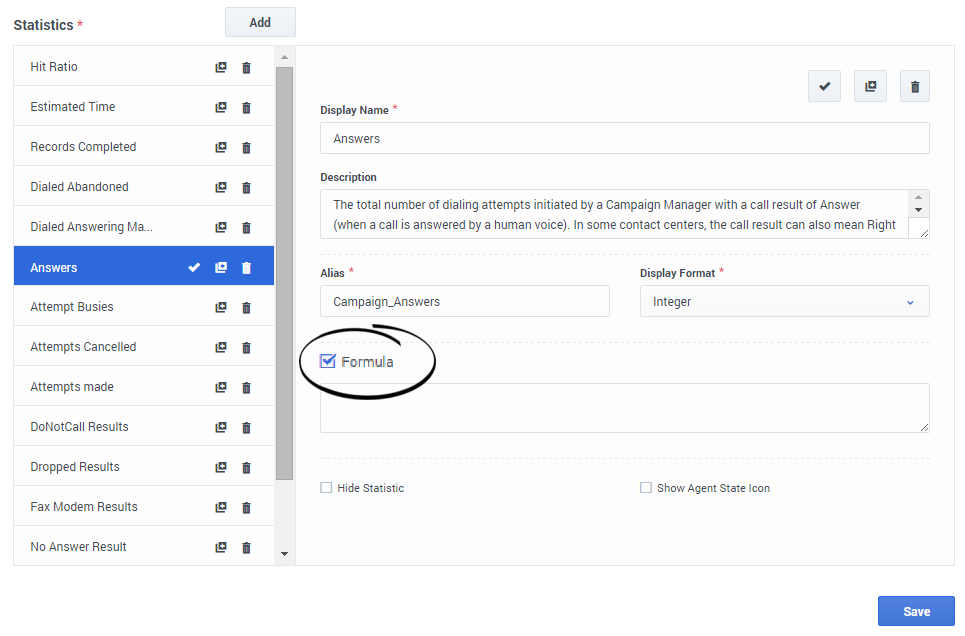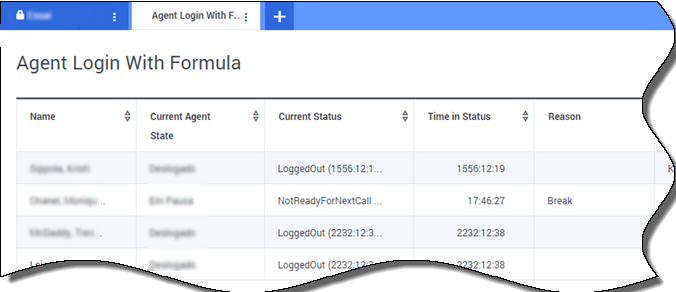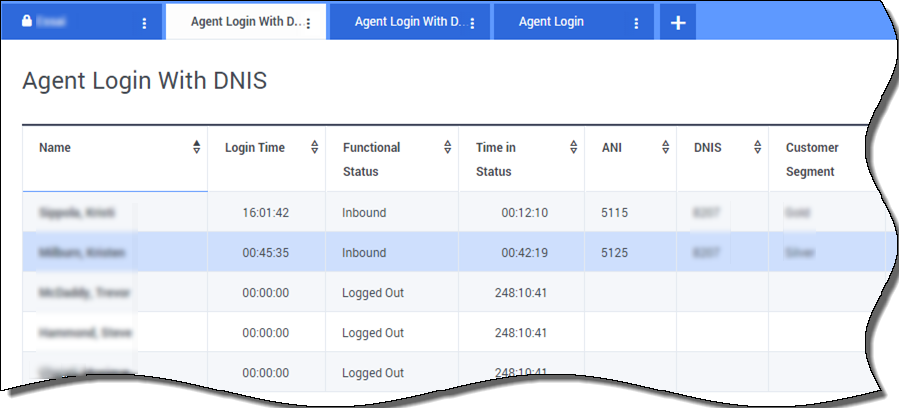(Update with the copy of version: 8.5.1draft) |
(Update with the copy of version: 8.5.1draft) |
||
| Ligne 1 : | Ligne 1 : | ||
| − | =Report Formulas | + | =Formules de rapport= |
| − | + | {{#anc:Report Formulas}} | |
| + | Si vous décidez que l’un de vos rapports a besoin d'une statistique différente ou supplémentaire, vous pouvez modifier le modèle de rapport pour répondre à votre besoin. Pour ce faire, ajoutez une formule au modèle de rapport pour récupérer la statistique ou l’indicateur de performance clé (KPI) souhaité. | ||
| − | + | Étant donné que vous ne pouvez pas modifier les modèles standard fournis, si vous souhaitez modifier l’un des rapports standard, il vous suffit de créer un clone du modèle et de le modifier. | |
| − | + | Qui peut créer ces statistiques ? Si vous pouvez créer et modifier des modèles Genesys Pulse, vous pouvez utiliser des formules. | |
__TOC__ | __TOC__ | ||
| − | {{NoteFormat| | + | {{NoteFormat|Si vous savez déjà comment utiliser les formules, vous pouvez utiliser [[RTRFunctions|la bibliothèque de fonctions]] pour vous aider à créer vos formules.}} |
{{CloudStep_Stack | {{CloudStep_Stack | ||
| − | |title= | + | |title=Ajouter une formule |
| − | |text= | + | |text=Dans le panneau de détails des statistiques lors de la modification d’un widget ou d’un modèle, vous pouvez créer ou personnaliser des statistiques en créant une formule. |
| − | + | La formule se base sur une syntaxe javascript, qui vous permet de calculer des expressions avec des valeurs fournies par d'autres statistiques et d’utiliser des fonctions fournies par Genesys pour obtenir des calculs plus spécifiques. Par exemple, vous pouvez calculer le rapport des appels abandonnés par rapport aux appels présentés dans votre file d'attente pour mesurer le pourcentage d'appels abandonnés de votre file d'attente. | |
|media1=Pulse_85105_Formulas2.png | |media1=Pulse_85105_Formulas2.png | ||
}} | }} | ||
| Ligne 20 : | Ligne 21 : | ||
{{CloudStep_Stack | {{CloudStep_Stack | ||
| − | |title= | + | |title=Afficher les pourcentages |
| − | |text= | + | |text=Imaginons que vous souhaitez afficher des pourcentages basés sur deux métriques. Il vous suffit de copier l'exemple suivant, en utilisant les statistiques souhaitées. |
| − | + | Dans cet exemple, nous souhaitons récupérer le pourcentage d'appels sortants par rapport au total d'appels entrants et sortants. La formule peut accéder à n’importe quelle statistique dans un modèle avec la syntaxe suivante : <tt>Données.''Alias statistique''.Valeur</tt>. La formule doit renvoyer une valeur <tt>Result</tt> valide. | |
| − | + | Dans la formule suivante, nous supposons que les appels sortants sont définis par un alias statistique <tt>Sortant</tt> et les appels entrants par un alias statistique <tt>Entrant</tt>. | |
| − | ''' | + | '''Formule : Calculer un pourcentage''' |
<div style="line-height:normal;border:1px dashed #2f6fab;background-color: #F9F9F9;color:black;padding:1em;margin:1em 0;"> | <div style="line-height:normal;border:1px dashed #2f6fab;background-color: #F9F9F9;color:black;padding:1em;margin:1em 0;"> | ||
<source enclose="div" lang="javascript">if ((Data.Outbound.Value + Data.Inbound.Value) != 0) | <source enclose="div" lang="javascript">if ((Data.Outbound.Value + Data.Inbound.Value) != 0) | ||
| Ligne 37 : | Ligne 38 : | ||
{{CloudStep_Stack | {{CloudStep_Stack | ||
| − | |title= | + | |title=Afficher les KPI d’état des agents |
| − | |text= | + | |text=Imaginons que vous souhaitez afficher des KPI pour l'état des agents. Il vous suffit d'utiliser la statistique <tt>Current_Status</tt>. |
| − | <toggledisplay linkstyle font-size:larger showtext="[+] | + | <toggledisplay linkstyle font-size:larger showtext="[+] Comment la statistique Current_Status est-elle définie" hidetext="[-] Comment la statistique Current_Status est-elle définie">{{ToggleTextWrapper}} |
| − | + | La statistique <tt>Current_Status</tt> est définie par les propriétés des options de Stat Server. Le type de statistique <tt>ExtendedCurrentStatus</tt> renvoie un objet spécifique qui peut être analysé davantage pour n'indiquer que la durée de l'objet. | |
| − | '''[ExtendedCurrentStatus]'''<br/> | + | '''[ExtendedCurrentStatus]'''<br/>Catégorie=CurrentState<br/>MainMask=*<br/>Objets=Agent<br/>Objet=DNAction |
</toggledisplay> | </toggledisplay> | ||
| − | + | Vous pouvez utiliser des formules pour trouver les informations dont vous avez besoin : | |
| − | <toggledisplay linkstyle font-size:larger showtext="[+] | + | <toggledisplay linkstyle font-size:larger showtext="[+] Afficher la durée de l’état actuel d’un agent" hidetext="[-] Afficher la durée de l’état actuel d’un agent">{{ToggleTextWrapper}} |
| − | + | Vous pouvez afficher la durée de l'état actuel d’un agent à l'aide de la statistique <tt>Current_Status</tt>. | |
| − | ''' | + | '''Formule : Obtenir la durée de l'état''' |
<div style="line-height:normal;border:1px dashed #2f6fab;background-color: #F9F9F9;color:black;padding:1em;margin:1em 0;"> | <div style="line-height:normal;border:1px dashed #2f6fab;background-color: #F9F9F9;color:black;padding:1em;margin:1em 0;"> | ||
<source enclose="div" lang="javascript">Result = G.GetStatusDuration(Data.Current_Status.Value);</source></div> | <source enclose="div" lang="javascript">Result = G.GetStatusDuration(Data.Current_Status.Value);</source></div> | ||
| Ligne 58 : | Ligne 59 : | ||
<p> | <p> | ||
| − | <toggledisplay linkstyle font-size:larger showtext="[+] | + | <toggledisplay linkstyle font-size:larger showtext="[+] Afficher le code de raison sélectionné par l'agent" hidetext="[-] Afficher le code de raison sélectionné par l’agent">{{ToggleTextWrapper}} |
| − | + | Vous pouvez afficher le code de raison pour l'état d'un agent. | |
| − | ''' | + | '''Formule : Get Reason Code''' |
<div style="line-height:normal;border:1px dashed #2f6fab;background-color: #F9F9F9;color:black;padding:1em;margin:1em 0;"><source enclose="div" lang="javascript">Result = G.GetReasonCodes(Data.Current_Status.Value);</source></div> | <div style="line-height:normal;border:1px dashed #2f6fab;background-color: #F9F9F9;color:black;padding:1em;margin:1em 0;"><source enclose="div" lang="javascript">Result = G.GetReasonCodes(Data.Current_Status.Value);</source></div> | ||
| − | + | Si vous souhaitez afficher davantage de données utilisateur en plus du code de raison, vous devez activer la propriété Données supplémentaires (Données utilisateur) de la statistique et appliquer une formule pour filtrer uniquement le code de raison à partir de la statistique Current_Status obtenue, qui contient les données utilisateur et le code de raison. | |
| − | ''' | + | '''Formule : Filtrer uniquement le code de raison''' |
<div style="line-height:normal;border:1px dashed #2f6fab;background-color: #F9F9F9;color:black;padding:1em;margin:1em 0;"> | <div style="line-height:normal;border:1px dashed #2f6fab;background-color: #F9F9F9;color:black;padding:1em;margin:1em 0;"> | ||
<source enclose="div" lang="javascript">var res = G.GetReasonCodes(Data.Current_Status.Value); | <source enclose="div" lang="javascript">var res = G.GetReasonCodes(Data.Current_Status.Value); | ||
| Ligne 83 : | Ligne 84 : | ||
<p> | <p> | ||
| − | <toggledisplay linkstyle font-size:larger showtext="[+] | + | <toggledisplay linkstyle font-size:larger showtext="[+] Afficher l'état actuel de l'agent par type de média" hidetext="[-] Afficher l’état actuel de l’agent par type de média">{{ToggleTextWrapper}} |
| − | + | Vous pouvez afficher l'état actuel de l'agent par type de média. | |
| − | ''' | + | '''Formule - Obtenir l'état de l'agent par type de média''' |
<div style="line-height:normal;border:1px dashed #2f6fab;background-color: #F9F9F9;color:black;padding:1em;margin:1em 0;"> | <div style="line-height:normal;border:1px dashed #2f6fab;background-color: #F9F9F9;color:black;padding:1em;margin:1em 0;"> | ||
<source enclose="div" lang="javascript">Result = G.GetAgentNonVoiceStatus(Data.Current_Status.Value, 'email');</source></div> | <source enclose="div" lang="javascript">Result = G.GetAgentNonVoiceStatus(Data.Current_Status.Value, 'email');</source></div> | ||
| Ligne 94 : | Ligne 95 : | ||
}} | }} | ||
{{CloudStep_Stack | {{CloudStep_Stack | ||
| − | |title= | + | |title=Afficher les propriétés d'interaction |
| − | |text= | + | |text=Imaginons que vous souhaitez afficher les propriétés d'interaction, y compris la segmentation des flux, l’ANI et la DNIS. Vous pouvez utiliser des formules pour trouver les informations dont vous avez besoin : |
<p> | <p> | ||
| − | <toggledisplay linkstyle font-size:larger showtext="[+] | + | <toggledisplay linkstyle font-size:larger showtext="[+] Afficher le segment clientèle de l'interaction" hidetext="[-] Afficher le segment clientèle de l’interaction">{{ToggleTextWrapper}} |
| − | + | Vous pouvez afficher le segment clientèle défini par la paire clé-valeur <tt>SegmentClientèle</tt> de l'interaction à l'aide de la formule suivante. | |
| − | ''' | + | '''Formule : Obtenir le segment clientèle''' |
<div style="line-height:normal;border:1px dashed #2f6fab;background-color: #F9F9F9;color:black;padding:1em;margin:1em 0;"> | <div style="line-height:normal;border:1px dashed #2f6fab;background-color: #F9F9F9;color:black;padding:1em;margin:1em 0;"> | ||
<source enclose="div" lang="javascript">Result = G.GetCustomerSegment(Data.Current_Status.Value);</source></div> | <source enclose="div" lang="javascript">Result = G.GetCustomerSegment(Data.Current_Status.Value);</source></div> | ||
| Ligne 106 : | Ligne 107 : | ||
</p> | </p> | ||
<p> | <p> | ||
| − | <toggledisplay linkstyle font-size:larger showtext="[+] | + | <toggledisplay linkstyle font-size:larger showtext="[+] Afficher l'ANI du client" hidetext="[-] Afficher l'ANI du client"> |
{{ToggleTextWrapper}} | {{ToggleTextWrapper}} | ||
| − | + | Vous pouvez afficher l'ANI du client à l'aide de la formule suivante. | |
| − | ''' | + | '''Formule : Obtenir l’ANI''' |
<div style="line-height:normal;border:1px dashed #2f6fab;background-color: #F9F9F9;color:black;padding:1em;margin:1em 0;"> | <div style="line-height:normal;border:1px dashed #2f6fab;background-color: #F9F9F9;color:black;padding:1em;margin:1em 0;"> | ||
<source enclose="div" lang="javascript">[Result = G.GetANI(Data.Current_Status.Value);</source></div> | <source enclose="div" lang="javascript">[Result = G.GetANI(Data.Current_Status.Value);</source></div> | ||
| Ligne 116 : | Ligne 117 : | ||
</p> | </p> | ||
<p> | <p> | ||
| − | <toggledisplay linkstyle font-size:larger showtext="[+] | + | <toggledisplay linkstyle font-size:larger showtext="[+] Afficher la DNIS du client" hidetext="[-] Afficher la DNIS du client">{{ToggleTextWrapper}} |
| − | + | Vous pouvez afficher la DNIS du client à l'aide de la formule suivante. | |
| − | ''' | + | '''Formule : Obtenir la DNIS''' |
<div style="line-height:normal;border:1px dashed #2f6fab;background-color: #F9F9F9;color:black;padding:1em;margin:1em 0;"> | <div style="line-height:normal;border:1px dashed #2f6fab;background-color: #F9F9F9;color:black;padding:1em;margin:1em 0;"> | ||
<source enclose="div" lang="javascript">Result = G.GetDNIS(Data.Current_Status.Value);</source></div> | <source enclose="div" lang="javascript">Result = G.GetDNIS(Data.Current_Status.Value);</source></div> | ||
| Ligne 127 : | Ligne 128 : | ||
}} | }} | ||
| − | + | {{#anc:What do I do next?}} | |
| − | + | ==Que faire ensuite ?== | |
| − | * [[RTRTemplates| | + | Vous pouvez en savoir plus à propos des fonctions suivantes : |
| − | * [[RTRStatProperties| | + | * [[RTRTemplates|Modèles de widgets]] |
| − | * [[RTRFunctions| | + | * [[RTRStatProperties|Propriétés statistiques]] |
| + | * [[RTRFunctions|Bibliothèque de fonctions de modèles]] | ||
[[Category:V:EZP:DRAFT]] | [[Category:V:EZP:DRAFT]] | ||
Version du mars 8, 2017 à 10:00
Formules de rapport
Si vous décidez que l’un de vos rapports a besoin d'une statistique différente ou supplémentaire, vous pouvez modifier le modèle de rapport pour répondre à votre besoin. Pour ce faire, ajoutez une formule au modèle de rapport pour récupérer la statistique ou l’indicateur de performance clé (KPI) souhaité.
Étant donné que vous ne pouvez pas modifier les modèles standard fournis, si vous souhaitez modifier l’un des rapports standard, il vous suffit de créer un clone du modèle et de le modifier.
Qui peut créer ces statistiques ? Si vous pouvez créer et modifier des modèles Genesys Pulse, vous pouvez utiliser des formules.
Sommaire
Ajouter une formule
Dans le panneau de détails des statistiques lors de la modification d’un widget ou d’un modèle, vous pouvez créer ou personnaliser des statistiques en créant une formule.
La formule se base sur une syntaxe javascript, qui vous permet de calculer des expressions avec des valeurs fournies par d'autres statistiques et d’utiliser des fonctions fournies par Genesys pour obtenir des calculs plus spécifiques. Par exemple, vous pouvez calculer le rapport des appels abandonnés par rapport aux appels présentés dans votre file d'attente pour mesurer le pourcentage d'appels abandonnés de votre file d'attente.
Afficher les pourcentages
Imaginons que vous souhaitez afficher des pourcentages basés sur deux métriques. Il vous suffit de copier l'exemple suivant, en utilisant les statistiques souhaitées.
Dans cet exemple, nous souhaitons récupérer le pourcentage d'appels sortants par rapport au total d'appels entrants et sortants. La formule peut accéder à n’importe quelle statistique dans un modèle avec la syntaxe suivante : Données.Alias statistique.Valeur. La formule doit renvoyer une valeur Result valide.
Dans la formule suivante, nous supposons que les appels sortants sont définis par un alias statistique Sortant et les appels entrants par un alias statistique Entrant.
Formule : Calculer un pourcentage
if ((Data.Outbound.Value + Data.Inbound.Value) != 0)
Result = 100 * Data.Outbound.Value / (Data.Outbound.Value + Data.Inbound.Value);
else Result = 0;Afficher les KPI d’état des agents
Imaginons que vous souhaitez afficher des KPI pour l'état des agents. Il vous suffit d'utiliser la statistique Current_Status.
[+] Comment la statistique Current_Status est-elle définie


